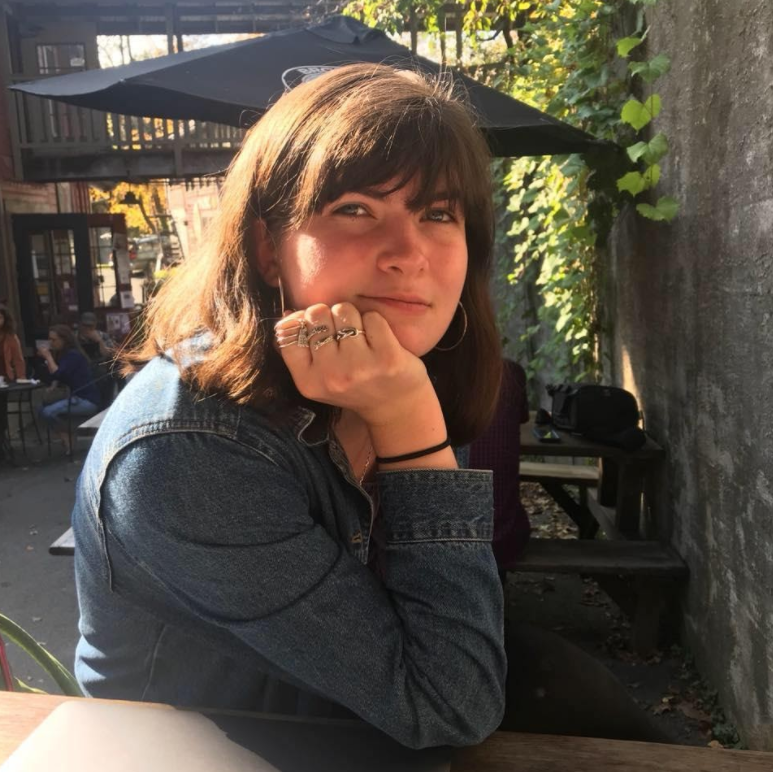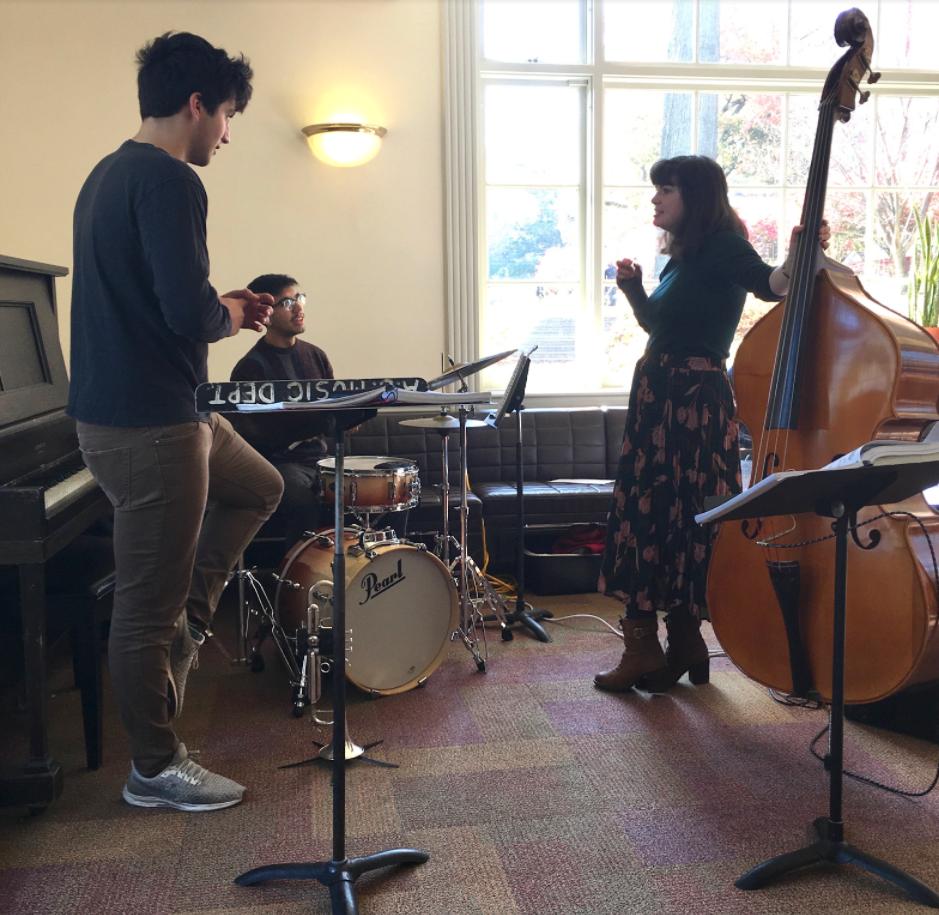Sarah Montoya: How Family History Led to a Fulbright
Sarah Montoya has always pushed for Indigenous rights and recognition at Amherst as the president of the Native and Indigenous Students Association (NISA). As a Fulbright scholar, her plans beyond graduation will include traveling to Lithuania to teach about Indigenous identities and history.


At the start of our interview, Sarah Montoya ’21 seemed businesslike. We barely exchanged greetings before jumping right into the questions. But, as we kept talking, things felt more and more comfortable and, by the end of the interview, I felt like I knew her quite well.
Montoya is easy to talk to. There were almost no lapses in our conversations, and, once she warms up to you, she has a fantastic sense of humor that makes you feel comfortable around her. It is easy to see that she is grounded and practical. She is determined, and once she sets her mind to something, nothing can stop her. A charismatic person, she grabs your attention, and you want to hang on to every word. These characteristics have made her a natural leader. As such, she has served as president of the Native and Indigenous Students Association (NISA), as well as a board member of the Lakota Youthstay — a program that connects Native American youth with hosts in the greater Boston area — and a Fulbright recipient.
Hailing from Belmont, MA, Montoya is an environmental studies major, focusing on environmental justice, with a focus on the Navajo Nation. Both Montoya and her father are Navajo, and she wears this on her sleeve as a badge of honor. Her mother is of Lithuanian descent. She values both of these cultures and considers them part of her identity. You can see this in her involvement in many Indigenous groups and programs both on and off campus, as well as her intention to go to Lithuania after graduation. She grew up surrounded by music, which she pursued both in high school — where she was involved in marching band, jazz ensemble, jazz combo and pit orchestra — and here at Amherst, where she has been involved in both the orchestra and jazz programs.
Identity and Amherst
Montoya was introduced to Amherst through College Horizons — a non-profit that provides Native American students with college application workshops and resources. She was supposed to go on a week-long trip with the organization to Amherst, but was unable to due to a concussion. This concussion led to a long legal battle with her high school that exhausted her, and after it was finished, she was looking for a fresh start. That fall, she took “Law and Disorder” with Professor Mona Oraby, as well as “Footprints on the Earth” with Professor Hannah Holleman. These two subjects both took hold of her interest, and she ended up taking many classes in the law, jurisprudence, and social thought (LJST), while also majoring in environmental studies.
Within the Navajo Nation, Montoya was born for the Ute Clan, and she considers this an important part of her identity. When she was a child, her grandmother said to her: “the only people who care about Navajo women are Navajo women.” This powerful statement stuck with her, and is one of the reasons that she became involved with Native groups on campus and beyond. During her first year at Amherst, she was appointed president of NISA. One of the first things she did was organize a vigil for a missing and murdered Indigenous woman: “It was after Tina Fontaine … was murdered. The guy who was accused of killing her got off. And [lots of people] were basically saying, oh, she did this to herself, or, there were drugs in her system. And this is just a 15-year-old kid. And that’s why I planned that event. I was so upset I couldn’t even sleep.”
Another of Montoya’s accomplishments as president of NISA was getting Amherst College to recognize Indigenous Peoples’ Day, which, as she says, was a tough battle. For the Bicentennial Celebration, Montoya is working to get the college to release a Permanent Land Acknowledgement, a formal statement (in this case, a plaque) that recognizes the land that the college now stands on as Native land, and that Indigenous peoples are the longstanding occupiers and caretakers of the land.
One of Montoya’s goals as president was to create a welcoming space on campus for Native students. She told me about how many Native people cannot register as Native with the government because of trivial details — a misspelling on the birth certificate, for example — or because of the fact that the government determines Native identity based on the amount of “Native blood” you have — a colonial construct. She tries to make people who are in such scenarios feel welcome.
The Dickinsons and Ancient Cookbooks
Montoya has a special bond with Lisa Brooks, a professor of American studies and English. They met during Montoya’s first semester and got to talking after they found out that Brooks had been a professor to Montoya’s auntie, Ethel Branch — who is the former attorney general of the Navajo Nation — at Harvard.
When Montoya was interested in finding a summer job at the end of her sophomore year, she reached out to Brooks. Montoya ended up helping Brooks on a research project about the Dickinson family and their relationship with Native Americans. She spent the summer reading all of Emily Dickinson’s letters. The Dickinsons’ had gained much of their wealth and prestige during the French and Indian Wars, and were actively present and involved with many of the massacres of Native people that happened during the war.
Brooks recalls Montoya often coming to her office right after visiting the Dickinson house “just bubbling with new information … about Emily and her family and their relationship to Native dispossession. And even though it’s about some pretty heavy dark history, Sarah would be effervescent … When she’s walking by Emily’s house, she’s also walking with Emily.”
When I asked her what she thought about Montoya, Brooks, without hesitation, said: “Her leadership skills have always really impressed me … She’s delightfully quirky and eclectic.”
To this day, Montoya has still not read a single Emily Dickinson poem.
Montoya also has done research after receiving the 2020 Folger Shakespeare Library Fellowship. She and 8 other students had the task of translating a cookbook from 1740. The students had the job of transcribing and even recreating the centuries-old recipes. There were many instances of reading between the lines (for example, adjusting the 7 pounds of flour that the recipe dictated for a plum cake), and the fellowship culminated in a feast of traditional mid-18th century food.

A Musical Life
Montoya has been around music since a very young age. Her mother listened to songs on the radio all around the house, and her grandfather played the guitar.
This music-heavy environment inspired her to start playing upright bass, her primary instrument, in elementary school — despite being told she was too short for the bass. Since then, Montoya has been involved in music programs for all four of her years at Amherst. She has participated in orchestra, jazz combo and jazz ensemble. Jazz Director Bruce Diehl said: “I think her best work was with the jazz ensemble this semester.”
Her favorite artist of all time is Charles Mingus. Famous for his temper, Montoya told me how “he was kicked out of the Ellington band for chopping up Juan Tizol’s [the trombonist] chair with a fire axe while on stage.” Other artists she enjoys are Dusty Springfield, Warren Zevon, Rina Sawayama and Dmitri Shostakovitch.
Montoya also mentioned that she has a way of listening to music that I found interesting. She listens to one song on repeat for hours, sometimes days, paying attention to each instrument, one at a time and how they all work together. She credits this to her training as a musician since a very young age.
In addition to playing music, Montoya spends her free time talking with people — friends and strangers alike — and has recently been taking a beadwork class. She also loves talking with her grandparents, and fondly remembers the conversations with her late Lithuanian grandmother.
Love, Life and Lithuania
Montoya grew up hearing her mother’s Lithuanian folk stories and eating her grandmother’s homemade Lithuanian cooking. But neither her mother nor her grandmother had been the most informative when it came to their Lithuanian heritage. This inspired her, and by the time she was 12 years old, she would tell anyone who would listen about how she would go and live in Lithuania when she was older so that she could learn about the culture of her grandmother. And that’s exactly what she plans to do now. As a Fulbright Scholar, she is going to go teach English in Lithuania.
She plans to teach Lithuanians about her culture, both as an American and a Native American, including everything from unions to the Black freedom struggle to Indigenous peoples. She hopes to be able to educate people on the colonial history of the United States, as well as about Native tribes, cultures, and their relation to the United States and its government.
Afterwards, Montoya doesn’t have too many plans. She hopes to be able to just live in the present and appreciate the culture of her grandmother.





Comments ()